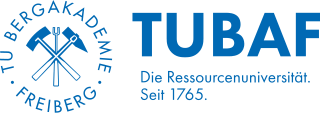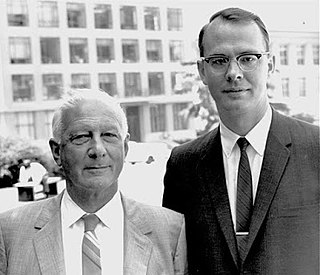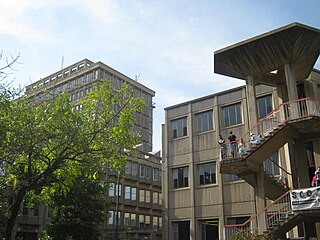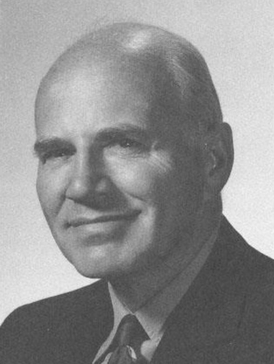Related Research Articles

The Norwegian Institute of Technology was a science institute in Trondheim, Norway. It was established in 1910, and existed as an independent technical university for 58 years, after which it was merged into the University of Trondheim as an independent college.

The UC Berkeley College of Chemistry is one of the fifteen schools and colleges at the University of California, Berkeley. It houses the department of chemistry and the department of chemical and biomolecular engineering.

The Technische Universität Bergakademie Freiberg is a public university of technology with 3,471 students in the city of Freiberg, Saxony, Germany. The university's focuses are exploration, mining & extraction, processing, and recycling of natural resources & scrap, as well as developing new materials and researching renewable energies. It is highly specialized and proficient in these fields.
Mark Sebastian Wainwright is an Australian chemical engineer and emeritus professor of the University of New South Wales, and institutional leader within the Australian academic and technological sectors. He served as seventh vice chancellor and president of the UNSW from 2004 to 2006. In 2004 he was appointed a member of the Order of Australia for services to chemical engineering as a researcher and academic, and to tertiary education. In 2007 he was awarded an honorary doctorate of science by the University of New South Wales. He was born 20 Oct.,1943.

The Clausthal University of Technology is an institute of technology in Clausthal-Zellerfeld, Lower Saxony, Germany. The small public university is regularly ranked among the Top German universities in engineering by CHE University Rankings. More than 30% of students and 20% of academic staff come from abroad, making it one of the most international universities in Germany. The university is best known for the prominent corporate leaders among its former students.

Antoine Marc Gaudin was a metallurgist who laid the foundation for understanding the scientific principles of the froth flotation process in the minerals industry. He was also a professor at the Massachusetts Institute of Technology, and during World War II developed there the ore-processing techniques needed to extract uranium from its low grade ores for the Manhattan Project. He was a founding member of the National Academy of Engineering.

Krzysztof "Kris" Matyjaszewski is a Polish-American chemist. He is the J.C. Warner Professor of the Natural Sciences at the Carnegie Mellon University Matyjaszewski is best known for the discovery of atom transfer radical polymerization (ATRP), a novel method of polymer synthesis that has revolutionized the way macromolecules are made.
Jacob Nissim Israelachvili, was an Israeli physicist who was a professor at the University of California, Santa Barbara (UCSB).

Tadimety Chakrapani Rao, also known as T.C. Rao, is an Indian mineral processing scientist and researcher.

The School of Chemical and Metallurgical Engineering is one of seven schools in the University of the Witwatersrand's Faculty of Engineering and the Built Environment. The School offers 4-year undergraduate degrees and post-graduate degrees in chemical and metallurgical engineering.
Martina Heide Stenzel is a Professor in the Department of Chemistry at the University of New South Wales (UNSW). She is also a Royal Australian Chemical Institute (RACI) University Ambassador. She became editor for the Australian Journal of Chemistry in 2008 and has served as Scientific Editor and as of 2021, as Editorial Board Chair of RSC Materials Horizons.
Ian Geoffrey Gould is a former Chancellor of the University of South Australia (2008–2015) and former Managing Director (Australia) of Rio Tinto Group. Gould is considered to be one of South Australia's most influential people.

John Frank Elliott was an American professor of metallurgy who made significant contributions to the science of pyrometallurgy during his long career at Massachusetts Institute of Technology (MIT).
Prafulla Kumar Jena was an Indian metallurgist who served as director of the National Institute for Interdisciplinary Science and Technology of the Council for Scientific and Industrial Research, Bhubaneshwar. He previously held the TATA Chair for the Distinguished Professor of Metallurgical Engineering at the Indian Institute of Technology, Kharagpur. He was awarded the Padma Shri, India's fourth highest civilian award, in 1977.

David Henry Solomon is an Australian polymer chemist. He is best known for his work in developing Living Radical Polymerization techniques, and polymer banknotes.
Hong Yong Sohn is an American engineer, currently a Distinguished Professor in Metallurgical Engineering at the University of Utah.
The SA Scientist of the Year is awarded by the South Australian State Government for eminence in science as part of the annual SA Science Excellence and Innovation Awards.
Georges John Kipouros is a Greek Canadian materials engineer, university professor, and former dean of the University of Saskatchewan College of Engineering. He presently serves as adjunct professor at the Faculty of Engineering of both Dalhousie University and University of Waterloo. He is the winner of the 20th Canadian Metal Chemistry Award, and is known as an ambassador for the engineering profession in Canada. At Dalhousie University he served as the vice chair of the Senate, assistant dean of the Faculty of Engineering, director of the Minerals Engineering Centre and head of the Mining and Metallurgical Engineering Department. He is known for his contributions to the processing of aluminum, magnesium, rare earth metals and molten salts, as well as the analysis of corrosion in additive manufacturing. In addition he is known as a major expert in powder metallurgy. He is the inventor of a technique for measuring metal corrosion in active pipelines, allowing for early detection of problem areas. At General Motors, he integrated the recovery and recycling of reactants into the production of neodymium from its oxide, rendering the process more cost-effective. He also led the technology transfer from laboratory research to plant production.

James Richard May was an Australian chemical engineer and company director who was the Chief Executive Officer of the Australian Minerals Industry Research Association Limited (AMIRA) between 1968 and 1994. He was also a fellow of a number of chartered institutions and organisations and was on various committees and academic institutes.
Aibing Yu is a Chinese–Australian chemical engineer, serving as Pro Vice-Chancellor and Foundation President (Suzhou) at Monash University where he is also Sir John Monash Distinguished Professor Director of ARC Research Hub for Smart Process Design and BHP-Baowu-Monash Knowledge Centre for LCM.
References
- 1 2 3 4 5 Pearce, Suzannah (2005). Who's Who in Australia, 1906-2006, XLII Edition. Crown Content Pty Ltd. p. 1620. ISBN 1740950232.
- 1 2 3 4 5 6 7 John, Ralston (2015). "Laureate Professor John Ralston". The University of South Australia . Retrieved 28 October 2023.
- 1 2 3 4 5 "Introducing our 2020 AusIMM Award recipients". Australasian Institute of Mining and Metallurgy . 1 April 2020. Retrieved 28 October 2023.
- 1 2 3 4 5 6 7 8 "Emeritus Laureate Professor John Ralston AO FAA FTSE" (PDF). ETH Zurich . Retrieved 28 October 2023.
- 1 2 "LPrf John Ralston". Australian Research Data Commons . Retrieved 28 October 2023.
- ↑ "UniSA STEM". The University of South Australia . 2015. Retrieved 29 October 2023.
- 1 2 "University of South Australia Minerals Processing R&D Real Value to the Resources Sector for More than 30 Years" (PDF). The University of South Australia . 2012. Retrieved 28 October 2023.
- ↑ "Centenary Medal entry for Professor John RALSTON". Australian Honours Database. Canberra, Australia: Department of the Prime Minister and Cabinet. 1 January 2001. Retrieved 28 October 2023.
- 1 2 "Laureate Professor John Ralston AO". The University of South Australia . Retrieved 28 October 2023.
- ↑ "Officer of the Order of Australia entry for Professor John RALSTON". Australian Honours Database. Canberra, Australia: Department of the Prime Minister and Cabinet. 9 June 2008. Retrieved 28 October 2023.
- ↑ "All Fellows". Australian Academy of Technology and Engineering . 2020. Retrieved 28 October 2023.
- 1 2 3 4 "Professional Associations". The University of South Australia . 2015. Retrieved 28 October 2023.
- ↑ "Fellows elected in 2005". Australian Academy of Science . Archived from the original on 25 March 2016. Retrieved 4 November 2023.